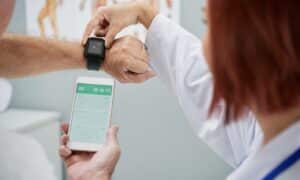Medically Reviewed By: Dr. Hanif Chatur
Table of Contents
ToggleKey Takeaways
-
Evolution Towards Comfort and Convenience: Noninvasive health monitoring, which includes tracking vital signs without penetrating the skin, offers numerous benefits such as eliminating pain, allowing continuous health tracking, reducing infection risks, and being cost-effective over time.
Challenges and the Future Landscape: Despite its potential, noninvasive health monitoring faces hurdles like ensuring accuracy, data security, and gaining widespread adoption. However, as technologies mature, the future of healthcare is leaning towards a paradigm where continuous, pain-free monitoring becomes standard, paving the way for proactive health management.
Leading Innovations in Noninvasive Monitoring: Technological advancements have introduced a range of noninvasive tools, from wearable devices like smartwatches to prickless glucose monitors and Remote Photoplethysmography, which detects heart rates using cameras.
In the last few decades, advances in technology have significantly impacted the healthcare sector. The medical industry pivot towards noninvasive health monitoring with the help of technology is one of the most exciting changes occuring right now. As technology evolves, the health monitoring paradigm is shifting from intrusive tests and procedures to seamless, noninvasive methods. But why is noninvasive monitoring gaining so much traction, and what does it hold for the future? Let’s delve into the details.
What is Noninvasive Health Monitoring?
At its core, noninvasive health monitoring implies tracking vital signs, body metrics, and other health indicators without penetrating the skin or body. Think of devices that measure the heart rate through a simple wristband, or tools that can check glucose levels without a prick.
Benefits of Going Noninvasive
- Comfort and Convenience: One of the most obvious advantages is the elimination of pain and discomfort. Routine checks become less challenging, especially for those who fear needles or invasive procedures.
- Continuous Monitoring: Noninvasive devices often allow for continuous monitoring, giving a more comprehensive view of one’s health. This is particularly beneficial for tracking conditions that can fluctuate throughout the day.
- Lower Risk of Infections: Since the skin remains unbroken, the risk of infections or complications reduces dramatically.
- Cost-Effective: In the long run, noninvasive methods can be more economical. There’s no need for repeated purchases of consumables like needles etc.
Innovations Leading the Way
Various technologies are emerging in the realm of noninvasive monitoring:
- Wearable Devices: From smartwatches that track your heart rate to shoes that can detect fatigue levels, wearables are at the forefront of this revolution.
- Remote Photoplethysmography (RPPG): A method that uses cameras to detect minute changes in skin color to monitor heart rates.
- Prickless Glucose Monitors: For diabetics, this is a breakthrough. Using sensors, these devices can monitor glucose levels without drawing blood.
Challenges Ahead
While the prospects are exciting, there are hurdles to overcome:
- Accuracy: It is absolutely critical to ensure that the data generated by noninvasive methods is as accurate as that produced by traditional ones.
- Data Security: With digital devices collecting health data, ensuring the privacy and security of the data collected assumes paramount importance.
- Adoption: Getting the medical community and patients on board with trusting and using new technologies can be a slow process.
The Road Ahead
The shift towards noninvasive health monitoring is not just a trend; it’s the future. As technologies mature and gain acceptance, we can expect a healthcare landscape where continuous, pain-free monitoring is the norm, leading to proactive health management and timely interventions.
In conclusion, noninvasive health monitoring presents an exciting horizon for healthcare, promising a blend of technology and well-being that enhances the quality of care and life. We find ourselves standing on the cusp of an unprecedented revolution;embracing and investing in these advancements is the only way forward.

Revolutionize Your Wellness Routine: Monitor Vital Signs Anywhere with Veyetals App

Experience the Future of Vitals Monitoring at HIMSS 2024

Understanding the Game-Changing Impact of Heart Rate Monitors on Cardiovascular Care and How You Can Use It
Unlock Your Health: Exploring the Power of Biometric Tracking for Wellness Insight

Revolutionizing ICU Patient Care: The Future of Contactless Monitoring Systems




